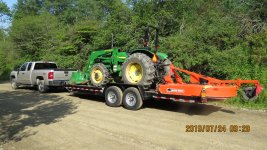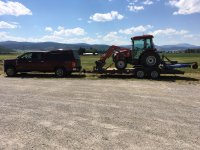bitternut
Silver Member
- Joined
- Nov 15, 2002
- Messages
- 143
- Location
- Western NY
- Tractor
- 2000 John Deere 5210 mfwd, John Deere 350C Crawler
I needed to haul my tractor and mower for the first time and had no idea how to position the load properly so that it hauled safely. I started out by putting the truck and empty trailer on as flat and level area that I had. Then I measured the height of the wheel wells and the hitch. I loaded the tractor and mower on the trailer and rechecked the measurements. After shuffeling things around a bit I ended up with the bucket flat and positioned against the trailers front rail. This gave me a slightly less height at the front wheel well, a height at the rear wheel well of less than 2" and just about 2" less at the ball.
I had no way to check the tongue weight but by measuring the heights and positioning the load I could vary all 3 heights by moving the load forward and aft. I did not know the weight of my load and no way to measure the tongue weight so I made the assumption that if my truck was carrying the load with the front wheels not rising it should steer normal.
Well the trailer steered and handled great. I knew it was there, especially going up and down the hills but on the flats it was like not having anything hooked on to the back. On the trip I pass by a truck stop along the NY Throughway ( I-90 ) that has a CAT SCALE so I decided to get the load weighed. The scale has 3 sections and gives you the weight on 3 axles.
STEER AXLE..............3120 lbs
DRIVE AXLE..............4700 lbs
TRAILER AXLE...........11040 lbs
GROSS WEIGHT.........18860 lbs
Now I have to get the weights with the empty trailer some day. Here is a picture of the loaded trailer. The trailer is rated for 15,000 lbs so I could have brought my 900 lbs grapple along, the post hole digger, the logging winch and the 8ft scraper blade. Just have to figure out how to stack them. Just kidding. Any ways that is how I figured out how to position the load so it would haul safely.
Here is a picture of the loaded trailer that was weighed. I red flagged the mower tail wheel which stuck out past the rear of my 23' trailer.

I had no way to check the tongue weight but by measuring the heights and positioning the load I could vary all 3 heights by moving the load forward and aft. I did not know the weight of my load and no way to measure the tongue weight so I made the assumption that if my truck was carrying the load with the front wheels not rising it should steer normal.
Well the trailer steered and handled great. I knew it was there, especially going up and down the hills but on the flats it was like not having anything hooked on to the back. On the trip I pass by a truck stop along the NY Throughway ( I-90 ) that has a CAT SCALE so I decided to get the load weighed. The scale has 3 sections and gives you the weight on 3 axles.
STEER AXLE..............3120 lbs
DRIVE AXLE..............4700 lbs
TRAILER AXLE...........11040 lbs
GROSS WEIGHT.........18860 lbs
Now I have to get the weights with the empty trailer some day. Here is a picture of the loaded trailer. The trailer is rated for 15,000 lbs so I could have brought my 900 lbs grapple along, the post hole digger, the logging winch and the 8ft scraper blade. Just have to figure out how to stack them. Just kidding. Any ways that is how I figured out how to position the load so it would haul safely.
Here is a picture of the loaded trailer that was weighed. I red flagged the mower tail wheel which stuck out past the rear of my 23' trailer.


